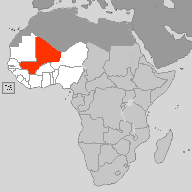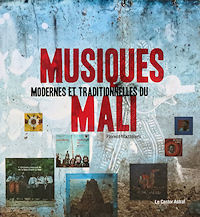| Bénin | Burkina Faso | Cabo Verde | Côte d’Ivoire | Gambia | Ghana | Guiné-Bissau | Guinée | Liberia | Mali | Mauritanie | Niger | Nigeria | Sénégal | Sierra Leone | Togo |
> Mali | Livres | Articles |

See as well / Voir aussi / Veja também “Afrique de l’Ouest en général – Livres”
Amadou & Mariam. Entretiens avec Idrissa Keïta:
À part la lumière du jour.
Neuilly-sur-Seine: Michael Lafon Publishing, 2008. 264 p.
ISBN 978-2-7499-0863
English edition
Amadou & Mariam with Idrissa Keïta:
Away from the Light of Day.
Pontefract: Route Publishing, 2010. 175 p.
Contents
Amico, Marta:
La fabrique d’une « musique touarègue » : un « son du désert » au prisme de la World Music.
Thèse. École des hautes études en sciences sociales EHESS (Paris), 2013. 553 p.
Num. national de thèse: 2013EHES0560
Bamba, Sorry (en collaboration avec Liliane Prévost):
De la tradition à la world music.
Paris: L’Harmattan, 1996. 271 p.
Table des matières
Bott, Evelyn:
Salif Keita: „Les belles choses derrière le mur“ – von Marginalisierung zu Weltruhm.
Arbeitspapiere Nr. 48, Institut für Ethnologie und Afrikastudien,
Johannes Gutenberg-Universität (Mainz), 2004. 177 p.
Inhalt – PDF Download / Télécharger / Baixar 2.17 MB
Bolly, Moussa:
Et si on parlait un peu d’Ali [Farka Touré].
Hommage du monde, homage du Mali.
Bamako: Cauris Éditions, 2007. 103 p.
Table des matières
Comtet, Julien:
Mémoires de djembéfola. Essai sur le tambour djembé au Mali.
Méthode d’apprentissage du djembé (avec partitions et CD).
Paris: L’Harmattan, 2012. 282 p. & CD
Table des matières
Diabaté, Massa M[akan]:
Janjon et autre chants populaires du Mali.
Paris : Présence Africaine, 1970. 111 p.
Table des matières
Diakité, Mandé Moussa:
La piraterie des oeuvres musicales dans le district de Bamako: cas du Dabanani.
Mémoire. L’Institut National de la Jeunesse et des Sports (Bamako), 2006.
Durán, Lucy:
Stars and Songbirds: Mande Female Singers in Urban Music, Mali 1980-99.
Ph.D. London University,1999.
Durán, Lucy:
Da Kali – the pledge to the art of the griot, Growing into Music in Mali Part I.
London: SOAS University of London, 2013. 86-minute documentary film
View online / Voir en ligne / Ver online
Durán, Lucy:
Dò Farala a Kan: something has been added. Growing into music in Mali Part II.
London: SOAS University of London, 2013. 70-minute documentary film.
View online / Voir en ligne / Ver online
Durán, Lucy:
The voice of tradition: Bako Dagnon and her family. Growing into music in Mali.
Winner,10th anniversary AHRC awards for research in films: Best AHRC-funded film since 1998
London: SOAS University of London, 2015. 30-minute documentary film
View online / Voir en ligne / Ver online
Eyre, Banning:
In Griot Time. An American Guitarist in Mali.
Philadelphia, Pa.: Temple University Press, 2000. 256 p. & CD
Contents
Harris, Corey:
Jahtigui. The Life and Music of Ali Farka Toure.
Richmond, Va.: Privately printed at CreateSpace, 2014. 105 p.
Contents
Keïta, Cheick M. Chérif:
Salif Keita. L’oiseau sur le fromager.
Bamako: Le Figuier, 2001. 123 p.
Table des matières
Réédition
Salif Keïta. L’ambassadeur de la musique du Mali.
Brinon-sur-Sauldre: Grandvaux, 2008. 170 p.
Table des matières
English edition
Outcast to Ambassador: The Musical Odyssey of Salif Keita.
Saint Paul, Minn.: Mogoya Books, 2011. 176 p.
Contents
Maxwell, Heather Anne:
Destiny’s Divas: Wassolu Singing, Music Ideologies,
and the Politics of Performance in Bamako, Mali.
Ph. D. Indiana University (Bloomington, Ind.), 2002. xiii & 412 p.
ProQuest no. 3076058
Mazzoleni, Florent:
Salif Keïta. La voix du Mandingue.
Paris: Éditions Demi-Lune, Collection Voix du Monde, 2009. 125 p.
Table des matières
Mazzoleni, Florent:
Musiques modernes et traditionelles du Mali.
Bègles: Le Castor Astral, 2011. 175 p.
Table des matières
Morgan, Andy:
Music, Culture and Conflict in Mali.
Copenhagen; Freemuse, 2013. 211 p.
Contents
Samake, S.:
La Semaine Nationale de la Jeunesse et la Biennale au Mali: Un meme objectif, deux strategies.
Mémoire. Institut National d’Education Populaire (Paris), 1983.
Schulz, Dorothea E[lisabeth]:
Perpetuating the Politics of Praise:
Jeli singers, radios, and political mediation in Mali.
[Ph.D. Yale University (New Haven, Conn.), 1996.]
Studien zur Kulturkunde, Vol.118.
Köln: Rüdiger Köppe Verlag, 2001. 296 p.
ISBN 978-3896-452-13-9
Sidibé, Séga :
Séga kan do. Rythmes du Mali / Rhythmes from Mali.
Apprentissage facile du solfège rythmique / A simple approach to rythmic solfege.
Réalisé et publié par Cyril Piquet, 2010. 137 p. CD & DVD
Table des matières
Skinner, Ryan Thomas:
Artistiya: Popular Music and Personhood in Postcolonial Bamako, Mali.
Ph.D. Columbia University (New York, N.Y.), 2009. 353 p.
Contents – PDF Download / Télécharger / Baixar 22.9 MB
Skinner, Ryan Thomas:
Bamako Sounds: The Afropolitan Ethics of Malian Music.
Minneapolis, Minn.: University of Minnesota Press, 2015. 248 p.
Contents
Touré, Younoussa:
La Biennale artistique et culturelle du Mali (1962-1988) :
socio-anthropologie d’une action de politique culturelle africaine.
Thèse. École des Hautes Études en Sciences Sociales (Marseille), 1998.
Touré [prénom inconnu]:
Le Mouvement Hip Hop au Mali: Un Mode d’Expression de la Jeunesse:
Une Analyse Socio-Anthropologique.
Mémoire. Faculte des Lettres, Langues, Arts, et Sciences Humaines. Universite de Bamako, 2004-5.
Page créée 15/07/2017 © afrobib.com

 CONTENTS
CONTENTS TABLE DES MATIÈRES
TABLE DES MATIÈRES INHALT
INHALT TABLE DES MATIÈRES
TABLE DES MATIÈRES TABLE DES MATIÈRES
TABLE DES MATIÈRES TABLE DES MATIÈRES
TABLE DES MATIÈRES CONTENTS
CONTENTS CD
CD CONTENTS
CONTENTS TABLE DES MATIÈRES
TABLE DES MATIÈRES TABLE DES MATIÈRES
TABLE DES MATIÈRES CONTENTS
CONTENTS TABLE DES MATIÈRES
TABLE DES MATIÈRES TABLE DES MATIÈRES
TABLE DES MATIÈRES CONTENTS
CONTENTS TABLE DES MATIÈRES / CONTENTS
TABLE DES MATIÈRES / CONTENTS CONTENTS
CONTENTS CONTENTS
CONTENTS
 CONTENTS
CONTENTS CONTENTS
CONTENTS INHALT (Button Type)
INHALT (Button Type) CONTENTS
CONTENTS